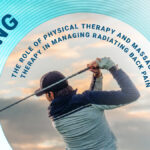Suffer From Sciatica? Try Massage Therapy
Contrary to popular belief, hearing the word “Sciatica” from your healthcare provider is not a diagnosis of a condition, but is instead a collection of symptoms that indicate damage or compression of the sciatic nerve or its surrounding tissues. Symptoms can be felt across the back of the hip or seat and spread down the leg to the toes, and can include everything from sharp, searing pain to intense stabbing, throbbing, aching, muscle weakness, numbness, tingling, and pins and needles sensations. These symptoms can occur whether you’re standing, sitting, walking, and even lying down. Needless to say, the symptoms can really interfere with daily activities, and while it may seem like pain-relievers would be your best bet for relief, therapeutic massage for sciatica is actually a much more effective alternative.
The Sciatic Nerve
The sciatic nerves are among the largest in the body, branching out from the central nervous column between vertebrae in the lower back and pelvis to provide communication with the lower half of the body. Usually felt on just one side, symptoms can vary because a number of nerves branch out from the sciatic nerve, passing through a number of structures that may be affected.
How can Massage Therapy Help Provide Sciatic Pain Relief?
The first courses of treatment for sciatica symptoms are always non-surgical modalities that include hands-on tissue manipulation like a therapeutic massage. A 2001 study published in the International Journal of Neuroscience showed that patients that received massage therapy reported less pain, less depression and anxiety, and improved sleep over those that used other techniques to manage their conditions. Massage therapists are highly trained to work on muscle and connective tissue around areas of pain or dysfunction, to improve mobility, to reduce pain, and to encourage healing.
- When we experience pain, our gait and posture often change to compensate for the injury, creating muscular imbalances. Over time, these imbalances create a painful cycle that leads to muscle tension and spasms that contribute to more sciatic pain, according to a Spine-Health article. Muscle massage can soothe and lengthen cramped or strained muscles and return balance to the mechanics of your physical movement.
- Massage Therapy will also stimulate increased circulation to the areas surrounding the injury. Improved blood flow will bring new nutrients and oxygen to the surrounding tissues, creating the healing conditions necessary for the body to recover from injury and to rebuild healthy cells.
- Sciatica pain relief can also be achieved through massage therapy because it helps move out waste produced by the body during the injury and the healing process. When injured, the body releases a special protein that triggers a painful inflammation response so we move with sensitivity to allow for healing. In many cases, long after an injury has healed, inflammatory proteins linger in the surrounding tissues, continuing a pain response when there is no need. Deep muscle massage can move out the waste that might be maintaining unnecessary pain.
Considering Alternatives to Sciatica Pain Relief?
Sciatic pain can have many sources and affect many different areas in the body, and it only makes sense to create pain relief and healing conditions in the body through a variety of non-surgical options like a therapeutic massage for your care. The professionals and Synergy Health can create a personal plan to help you find a more active, pain-free lifestyle; contact us today to learn more!




